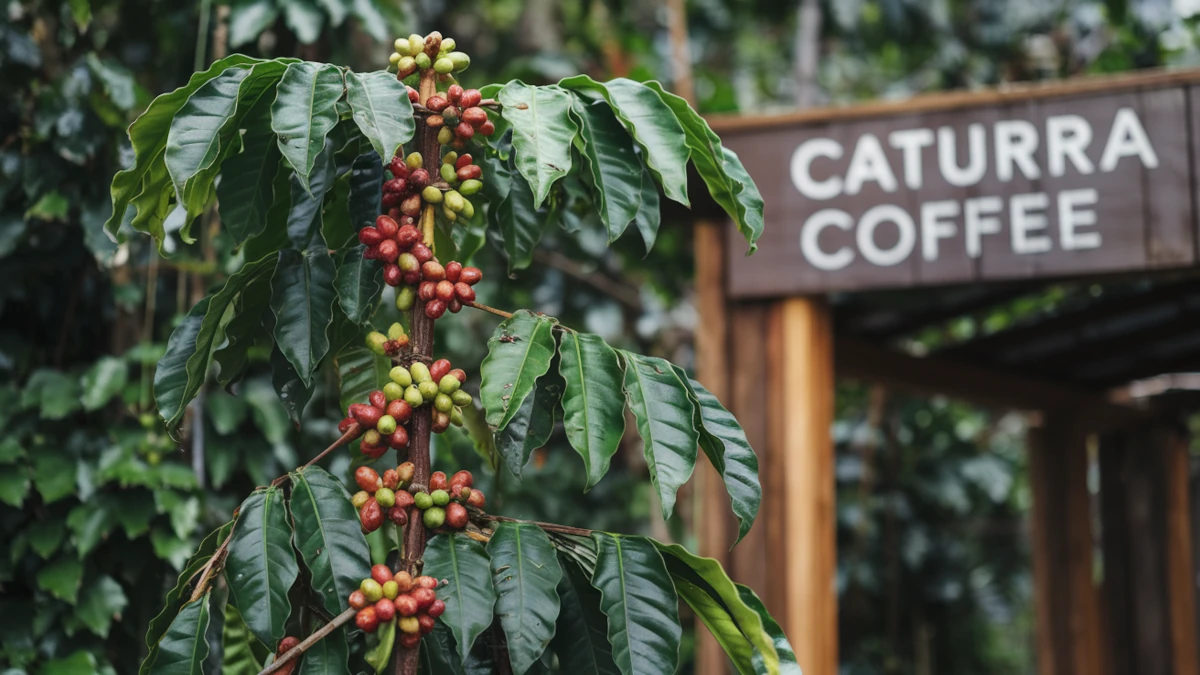Caturra coffee is a distinctive variety of Coffea arabica, celebrated for its compact growth and high yield. A natural mutation of the Bourbon coffee plant, it has earned its place as a key player in coffee cultivation worldwide. Known for its unique flavor profile, which includes bright acidity and fruity undertones, Caturra coffee is highly valued in specialty coffee circles. This article delves into the origins, characteristics, and significance of Caturra coffee, shedding light on its impact on coffee farming and global markets.
Table of Contents
Origins and History
Discovery in Brazil
Caturra coffee was discovered between 1915 and 1918 in Minas Gerais, Brazil. This natural mutation of the Bourbon variety displayed a single-gene mutation that caused the plant to grow shorter and more compact. The name “Caturra” is derived from the Guarani word for “small,” reflecting this key trait. Although it was initially researched by the Instituto Agronomico (IAC) in São Paulo, Caturra never gained official release in Brazil. However, it quickly spread across Central and South America, revolutionizing coffee farming in the region.
Spread Across Central and South America
After its discovery in Brazil, Caturra coffee reached Guatemala in the 1940s, then expanded to Costa Rica, Honduras, and Panama. Its compact nature and high yields made it a popular choice for farmers. By the mid-20th century, Caturra became a benchmark for testing new cultivars in these countries, and it played a significant role in boosting coffee production in Colombia, where it was responsible for nearly half of the country’s coffee output until the introduction of the Castillo variety in 2008.
Key Characteristics of Caturra Coffee
Plant Traits
- Compact Growth: Caturra’s dwarf-like stature allows for high-density planting and easier harvesting, making it ideal for regions with limited space for coffee production.
- High Productivity: This variety boasts efficient resource usage, producing high yields with shorter internodes, leading to better space utilization and faster growth.
- Disease Susceptibility: While Caturra coffee offers great productivity, it is prone to coffee leaf rust and coffee berry disease (CBD). Farmers need to manage these risks through careful farm practices.
- Overbearing: Caturra plants can produce more fruit than they can sustain, requiring balanced pruning to prevent overcrowding and maintain health.
Flavor Profile
The flavor of Caturra coffee beans is known for its brightness and fruitiness, making it a favorite among those who appreciate complex flavors. The flavor profile includes:
- Unroasted Beans: A distinctive blueberry aroma.
- Roasted Beans: Retaining the fruity notes of blueberry, with added nuances of chocolate, caramel, or citrus.
Optimal Growing Conditions
Caturra thrives at altitudes between 1,000–2,000 meters above sea level and flourishes in volcanic soils that provide the essential nutrients for its growth. Consistent rainfall is also key to achieving its distinctive flavor. However, higher altitudes can improve flavor complexity, though yield decreases.
Contribution to Coffee Varietals
Genetic Influence
Caturra’s unique traits have played a pivotal role in developing several hybrid coffee varieties. Its genetic influence can be seen in:
- Costa Rica 95
- Lempira
- Catimor (crossed with the Timor Hybrid for rust resistance)
- Castillo
These hybrids aim to balance flavor, disease resistance, and productivity, ensuring that the agricultural advantages of Caturra can be passed on while minimizing its vulnerabilities.
Economic and Agricultural Significance
Impact on Coffee Farming
The development of Caturra coffee revolutionized coffee farming, particularly in Central America. Its compact size allowed for high-density planting, which increased productivity per hectare and reduced labor costs associated with harvesting. This made it a key crop for small-scale farmers, bolstering the local economies of coffee-producing regions.
Commercial Relevance
Though Caturra beans are often blended with other varieties to cater to the mass market, they shine as single-origin coffees, particularly for specialty coffee enthusiasts. These high-quality, single-origin coffees highlight the distinctive characteristics of Caturra, making them a sought-after commodity in global coffee markets.
Notable Regions and Flavor Variations
Colombian Caturra
In Colombia, Caturra is prized for its bright acidity and pronounced fruitiness. This variety offers a lively cup with a crisp, refreshing finish.
Costa Rican Caturra
In Costa Rica, Caturra is known for its citrus notes and a delicate balance of sweetness, making it an appealing choice for coffee lovers seeking a well-rounded cup.
Nicaraguan Caturra
Nicaraguan Caturra coffee presents complex flavors, with rich chocolate and nutty undertones that make it a versatile choice for coffee drinkers who enjoy deep, multifaceted brews.
Conclusion
Caturra coffee has a rich history that spans nearly a century, originating in Brazil before spreading across Central and South America. Its compact size and high yields have made it an essential varietal in coffee farming, particularly in regions like Colombia, Costa Rica, and Nicaragua. With its unique flavor profile—marked by bright acidity, fruity notes, and hints of chocolate and caramel—Caturra continues to be celebrated for its contributions to the coffee industry.
